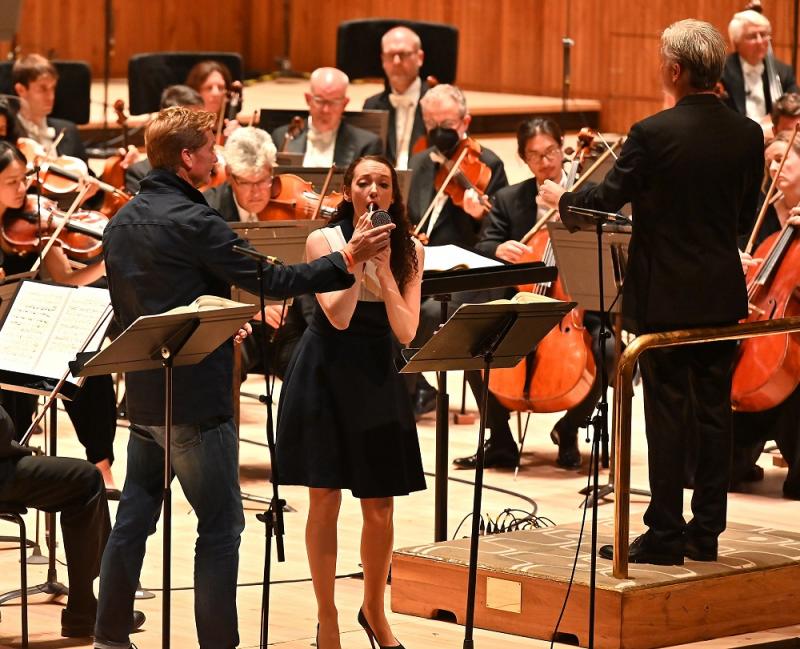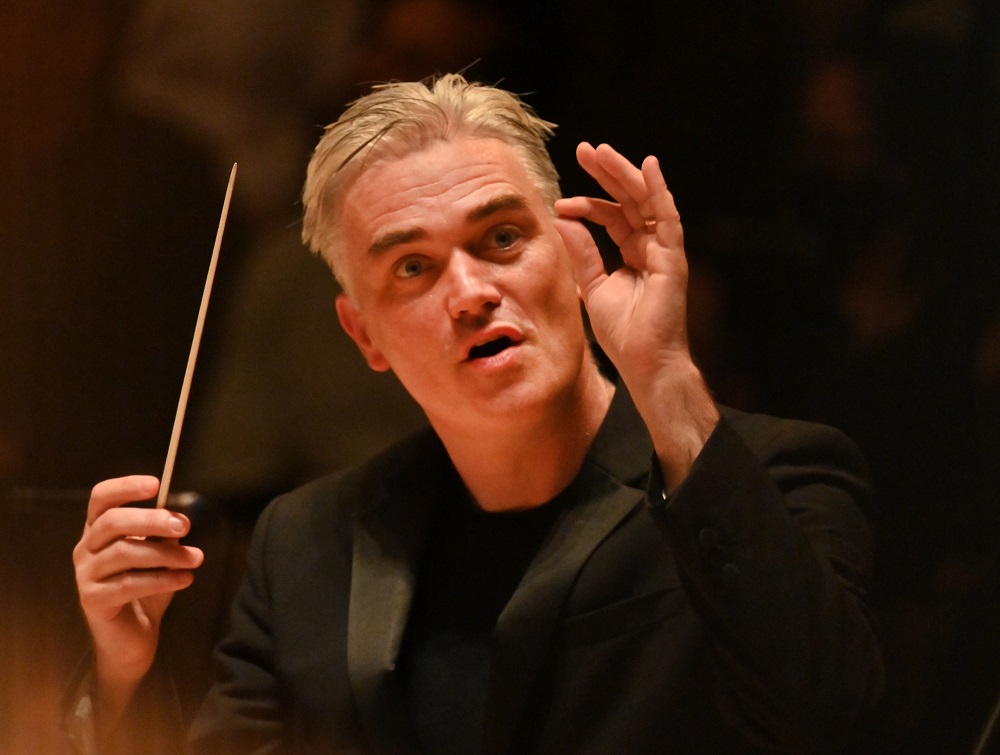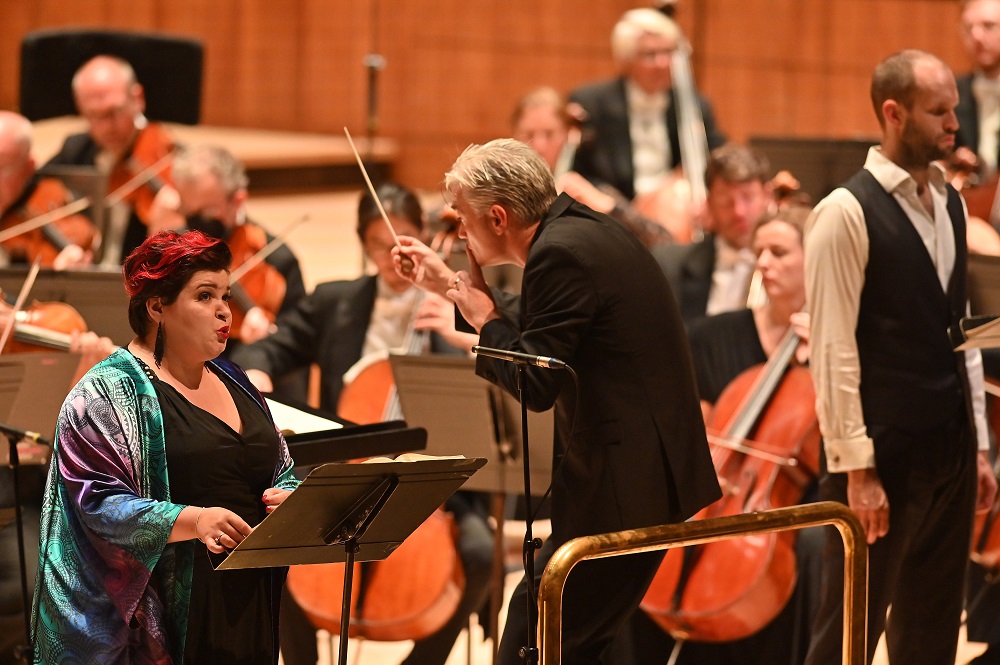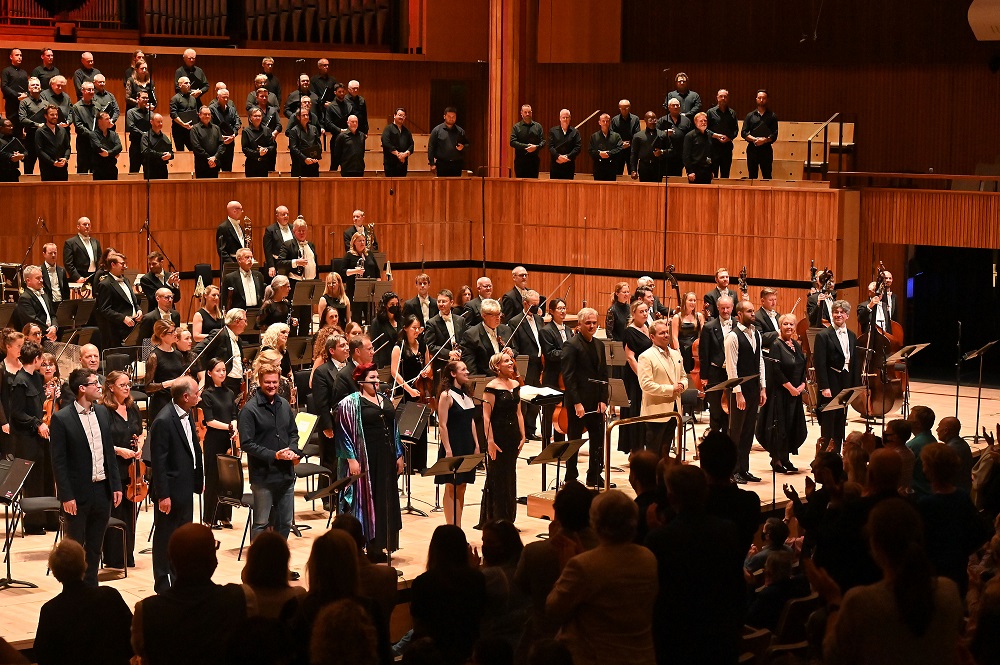The Midsummer Marriage, LPO, Gardner, RFH review – Tippett’s cornucopia shines in fits and starts | reviews, news & interviews
The Midsummer Marriage, LPO, Gardner, RFH review – Tippett’s cornucopia shines in fits and starts
The Midsummer Marriage, LPO, Gardner, RFH review – Tippett’s cornucopia shines in fits and starts
The central act is pure genius, but undramatic flaws glare in a naked concert performance

British opera’s attempted answer to The Magic Flute, and its presentation as the opening gambit of Edward Gardner’s eminent position as principal conductor of the London Philharmonic Orchestra, leave me queasily ambivalent.
After all the smoke and lighting of the LPO’s online series, there’s barely a hint of theatricality in this plain concert performance, with the only concession to lighting the constant red on the Royal Festival Hall organ: is it not an opera but a choral symphony with eight soloists? Then you remember what wonders good directors and designers have achieved with The Midsummer Marriage on stage, and realise that Tippett’s music, for all its stand-alone originality, really needs them. And was what we saw and heard in part the “vision” of the LPO’s former CEO, who wrote of how Brexit would offer bright opportunities for his orchestra? You have to wonder when the conductor and seven of the eight soloists are English born, with very little hint across the board of the diversity which ought to be part of an orchestra’s new-era statement.
But no: this was Gardner’s will for his new beginning (the conductor last night pictured below), giving a strong role to the combined London Philharmonic and English National Opera choruses (he was music director at ENO for a decade). The cast, though flawed, was truly international in quality; so is the music, for all its roots in an English mythology that is as unprovincial as the art of Paul Nash, Eric Ravilious and John Piper, or the sculpture of Elisabeth Frink and Barbara Hepworth, whose designs for the 1955 Royal Opera premiere were not deemed a success. Nor was Tippett’s own libretto, and much as one wants to fight against received wisdom, its symbolic and mythic platitudes, drawn from Tippett’s reading of Jung, invoking T S Eliot and, at the end, gauchely quoting Yeats, still stick in the craw too often.  What really took me aback, after I’d come to love the score, was its thick pastiness in swathes of Act One: the rhythmic dynamism, with all those dancing, lopsided metre changes, kicks off thrillingly and keeps the presentation of the midsummer temple and its celebrants/initiates afloat, but the orchestration felt often too blockish and too loud. Here we were with a full orchestra and chorus after 18 months of paring-back, and yet half of each would have kept it all more buoyant and focused. The betrothed couple, Mark too earthly and Jenifer too airy fairy, like the two couples presented in Act One of Strauss’s Die Frau ohne Schatten, remain abstractions throughout (Strauss, incidentally, bewailed the lack of characters with "red corpuscles", and at an earlier point in his collaboration with Hugo von Hofmannthal warned against ideas that weren't embodied in operatic action). The tenor part keeps going way too low for comfort, the soprano must have coloratura abilities and yet strength to drive against the thicker wadges, especially in the crazy copulatory Fire Dance of Act Three. Robert Murray and Rachel Nicholls could only hope to hit half the mark and it wasn’t their fault if the impact, ultimately was minimal.
What really took me aback, after I’d come to love the score, was its thick pastiness in swathes of Act One: the rhythmic dynamism, with all those dancing, lopsided metre changes, kicks off thrillingly and keeps the presentation of the midsummer temple and its celebrants/initiates afloat, but the orchestration felt often too blockish and too loud. Here we were with a full orchestra and chorus after 18 months of paring-back, and yet half of each would have kept it all more buoyant and focused. The betrothed couple, Mark too earthly and Jenifer too airy fairy, like the two couples presented in Act One of Strauss’s Die Frau ohne Schatten, remain abstractions throughout (Strauss, incidentally, bewailed the lack of characters with "red corpuscles", and at an earlier point in his collaboration with Hugo von Hofmannthal warned against ideas that weren't embodied in operatic action). The tenor part keeps going way too low for comfort, the soprano must have coloratura abilities and yet strength to drive against the thicker wadges, especially in the crazy copulatory Fire Dance of Act Three. Robert Murray and Rachel Nicholls could only hope to hit half the mark and it wasn’t their fault if the impact, ultimately was minimal.
The real success of the evening among the soloists belonged to the subsidiary couple, mechanic Jack and secretary Bella – a Papageno and Papagena who actually change before our eyes, unlike the rest of the dramatis personae. It’s interesting that though Bella’s coy dream of domestic wifery and feminine allure in Act Two seems so 1950s, her and Jack’s Act Two music is also other-worldly and ravishing around their retreats “into the shadow of the wood” while the selectively scored magic of seasonal animal pursuits – female predating upon male – held us spellbound in the first three “Ritual Dances”. Toby Spence, freed from heldentenorish push which could also make him a good Mark, was all straightforward charm and candour; Jennifer France, stage animal with a lighter-soprano voice that still cuts a swathe, could probably be a good Jenifer with one “n” too, but though the part isn’t intrinsically funny, she was the only one to bring character-led movement to life, crossing the podium from one set of music stands to question the ancient guardians of the temple (Joshua Bloom and Susan Bickley, also personable).
Toby Spence, freed from heldentenorish push which could also make him a good Mark, was all straightforward charm and candour; Jennifer France, stage animal with a lighter-soprano voice that still cuts a swathe, could probably be a good Jenifer with one “n” too, but though the part isn’t intrinsically funny, she was the only one to bring character-led movement to life, crossing the podium from one set of music stands to question the ancient guardians of the temple (Joshua Bloom and Susan Bickley, also personable).
There was a chance lost here to have fresh young singers straight out of music college as the two pairs of lovers, set against experienced old-timers in the other roles (that worked so well in the Aldeburgh staging of Britten’s Owen Wingrave). Ashley Riches started without the authority of Jenifer’s bullish businessman dad King Fisher, though he was impressive in Act Three (just how non-human the libretto is becomes risibly apparent when Jenifer, post-consummation, declares “I could love all – even my father had he lived,” and Mark responds “Mourn no stubborn father, but receive the ring”). The bully’s summoning of veiled creature Sosostris brings handsome hues from the lower orchestra and mezzo/contralto Claire Barnett-Jones (pictured above with Riches and Gardner)– clearly Wagner’s Erda appearing to Wotan is the model, not Elgar’s Angel to Gerontius, pace the programme note – but you feel King Fisher really needs to cut her off when she gets mired in heavy reflections; Tippett, as so often, labours too much of a good thing.  His biggest flop, surely, is not to fade with the birdsong of a new dawn but to write a big, Fidelio-style peroration for chorus – who should, incidentally, have been clad in flowery attire from the start – and ever-frantic orchestra making Yeats sound clumsy out of context (“All things fall and are built again/And those that build them again are gay”). We were asked, again in the well-written but uncritical programme note, to receive this as the big sentiment of a “post-COVID season” (don’t speak too soon). But it drove me away from involvement again. There’s far too much uniquely brilliant and fascinating music in The Midsummer Marriage for the evening to fail, and Gardner, from a perfunctory if precise start, ignited sparks in the second and third acts, especially from the chorus. That much, at least, will arise in the memory from the ruins of a flawed monument.
His biggest flop, surely, is not to fade with the birdsong of a new dawn but to write a big, Fidelio-style peroration for chorus – who should, incidentally, have been clad in flowery attire from the start – and ever-frantic orchestra making Yeats sound clumsy out of context (“All things fall and are built again/And those that build them again are gay”). We were asked, again in the well-written but uncritical programme note, to receive this as the big sentiment of a “post-COVID season” (don’t speak too soon). But it drove me away from involvement again. There’s far too much uniquely brilliant and fascinating music in The Midsummer Marriage for the evening to fail, and Gardner, from a perfunctory if precise start, ignited sparks in the second and third acts, especially from the chorus. That much, at least, will arise in the memory from the ruins of a flawed monument.
Add comment
The future of Arts Journalism
You can stop theartsdesk.com closing!
We urgently need financing to survive. Our fundraising drive has thus far raised £49,000 but we need to reach £100,000 or we will be forced to close. Please contribute here: https://gofund.me/c3f6033d
And if you can forward this information to anyone who might assist, we’d be grateful.

Subscribe to theartsdesk.com
Thank you for continuing to read our work on theartsdesk.com. For unlimited access to every article in its entirety, including our archive of more than 15,000 pieces, we're asking for £5 per month or £40 per year. We feel it's a very good deal, and hope you do too.
To take a subscription now simply click here.
And if you're looking for that extra gift for a friend or family member, why not treat them to a theartsdesk.com gift subscription?
more Opera
 Cinderella/La Cenerentola, English National Opera review - the truth behind the tinsel
Appealing performances cut through hyperactive stagecraft
Cinderella/La Cenerentola, English National Opera review - the truth behind the tinsel
Appealing performances cut through hyperactive stagecraft
 Tosca, Royal Opera review - Ailyn Pérez steps in as the most vivid of divas
Jakub Hrůša’s multicoloured Puccini last night found a soprano to match
Tosca, Royal Opera review - Ailyn Pérez steps in as the most vivid of divas
Jakub Hrůša’s multicoloured Puccini last night found a soprano to match
 Tosca, Welsh National Opera review - a great company reduced to brilliance
The old warhorse made special by the basics
Tosca, Welsh National Opera review - a great company reduced to brilliance
The old warhorse made special by the basics
 BBC Proms: The Marriage of Figaro, Glyndebourne Festival review - merriment and menace
Strong Proms transfer for a robust and affecting show
BBC Proms: The Marriage of Figaro, Glyndebourne Festival review - merriment and menace
Strong Proms transfer for a robust and affecting show
 BBC Proms: Suor Angelica, LSO, Pappano review - earthly passion, heavenly grief
A Sister to remember blesses Puccini's convent tragedy
BBC Proms: Suor Angelica, LSO, Pappano review - earthly passion, heavenly grief
A Sister to remember blesses Puccini's convent tragedy
 Orpheus and Eurydice, Opera Queensland/SCO, Edinburgh International Festival 2025 review - dazzling, but distracting
Eye-popping acrobatics don’t always assist in Gluck’s quest for operatic truth
Orpheus and Eurydice, Opera Queensland/SCO, Edinburgh International Festival 2025 review - dazzling, but distracting
Eye-popping acrobatics don’t always assist in Gluck’s quest for operatic truth
 MARS, Irish National Opera review - silly space oddity with fun stretches
Cast, orchestra and production give Jennifer Walshe’s bold collage their all
MARS, Irish National Opera review - silly space oddity with fun stretches
Cast, orchestra and production give Jennifer Walshe’s bold collage their all
 Káťa Kabanová, Glyndebourne review - emotional concentration in a salle modulable
Janáček superbly done through or in spite of the symbolism
Káťa Kabanová, Glyndebourne review - emotional concentration in a salle modulable
Janáček superbly done through or in spite of the symbolism
 Buxton International Festival 2025 review - a lavish offering of smaller-scale work
Allison Cook stands out in a fascinating integrated double bill of Bernstein and Poulenc
Buxton International Festival 2025 review - a lavish offering of smaller-scale work
Allison Cook stands out in a fascinating integrated double bill of Bernstein and Poulenc
 Tosca, Clonter Opera review - beauty and integrity in miniature
Happy surprises and a convincing interpretation of Puccini for today
Tosca, Clonter Opera review - beauty and integrity in miniature
Happy surprises and a convincing interpretation of Puccini for today
 Hamlet, Buxton International Festival review - how to re-imagine re-imagined Shakespeare
Music comes first in very 19th century, very Romantic, very French operatic creation
Hamlet, Buxton International Festival review - how to re-imagine re-imagined Shakespeare
Music comes first in very 19th century, very Romantic, very French operatic creation
 Falstaff, Glyndebourne review - knockabout and nostalgia in postwar Windsor
A fat knight to remember, and snappy stagecraft, overcome some tedious waits
Falstaff, Glyndebourne review - knockabout and nostalgia in postwar Windsor
A fat knight to remember, and snappy stagecraft, overcome some tedious waits

Comments
Erda is of course an
It's a brighter stretch of
It's a brighter stretch of her solo, but I'm not hearing it. More Hindemith, if anyone. Which bars of the Angel's Farewell exactly?